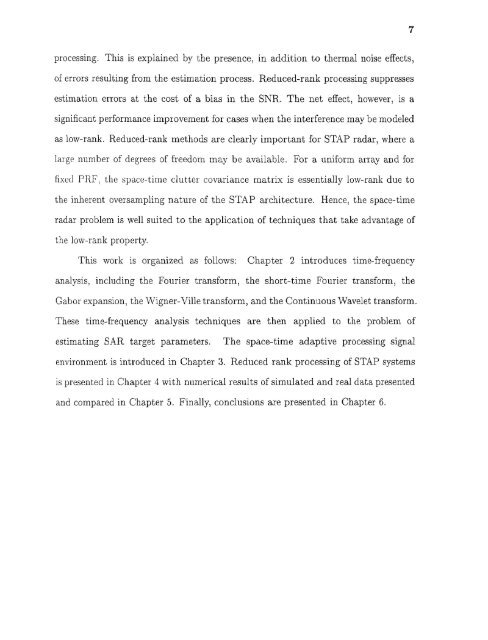Space/time/frequency methods in adaptive radar - New Jersey ...
Space/time/frequency methods in adaptive radar - New Jersey ...
Space/time/frequency methods in adaptive radar - New Jersey ...
You also want an ePaper? Increase the reach of your titles
YUMPU automatically turns print PDFs into web optimized ePapers that Google loves.
7process<strong>in</strong>g. This is expla<strong>in</strong>ed by the presence, <strong>in</strong> addition to thermal noise effects,of errors result<strong>in</strong>g from the estimation process. Reduced-rank process<strong>in</strong>g suppressesestimation errors at the cost of a bias <strong>in</strong> the SNR. The net effect, however, is asignificant performance improvement for cases when the <strong>in</strong>terference may be modeledas low-rank. Reduced-rank <strong>methods</strong> are clearly important for STAP <strong>radar</strong>, where alarge number of degrees of freedom may be available. For a uniform array and forfixed PRF, the space-<strong>time</strong> clutter covariance matrix is essentially low-rank due tothe <strong>in</strong>herent oversampl<strong>in</strong>g nature of the STAP architecture. Hence, the space-<strong>time</strong><strong>radar</strong> problem is well suited to the application of techniques that take advantage ofthe low-rank property.This work is organized as follows: Chapter 2 <strong>in</strong>troduces <strong>time</strong>-<strong>frequency</strong>analysis, <strong>in</strong>clud<strong>in</strong>g the Fourier transform, the short-<strong>time</strong> Fourier transform, theGabor expansion, the Wigner-Ville transform, and the Cont<strong>in</strong>uous Wavelet transform.These <strong>time</strong>-<strong>frequency</strong> analysis techniques are then applied to the problem ofestimat<strong>in</strong>g SAR target parameters. The space-<strong>time</strong> <strong>adaptive</strong> process<strong>in</strong>g signalenvironment is <strong>in</strong>troduced <strong>in</strong> Chapter 3. Reduced rank process<strong>in</strong>g of STAP systemsis presented <strong>in</strong> Chapter 4 with numerical results of simulated and real data presentedand compared <strong>in</strong> Chapter 5. F<strong>in</strong>ally, conclusions are presented <strong>in</strong> Chapter 6.
















